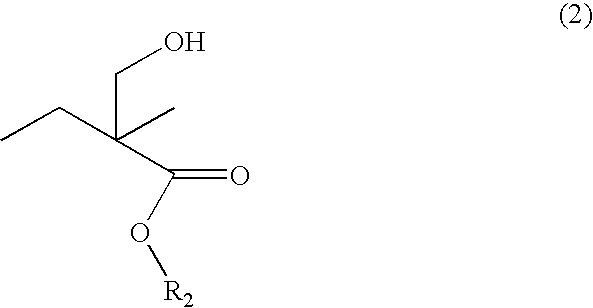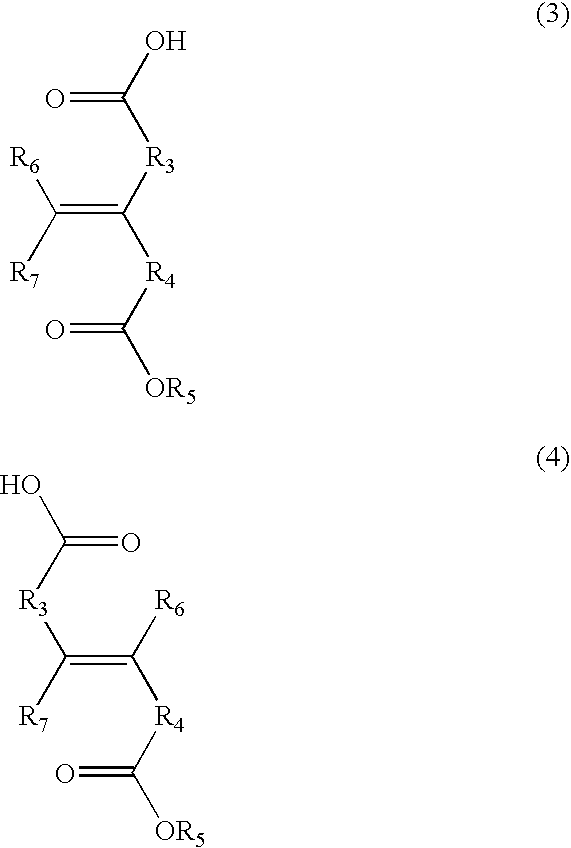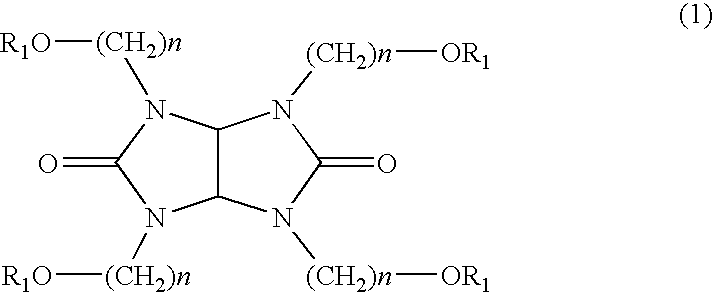Resist material for liquid immersion lithography process and method for forming resist pattern using the resist material
a liquid immersion lithography and resist material technology, applied in the field of resist materials, can solve the problems of shortening the wavelength of the light source, requiring an expensive new apparatus, and reducing the focal depth range, so as to improve the resolution of the resist pattern
- Summary
- Abstract
- Description
- Claims
- Application Information
AI Technical Summary
Benefits of technology
Problems solved by technology
Method used
Image
Examples
example 1
[0060] A negative resist material whose solid weight was 8.1% by weight was prepared by dissolving a resin component having a repeat unit represented by the following chemical formula (5):
wherein m:n is 84:16 (mol %), 10% by weight of a water-poorly soluble crosslinker composed of tetrabutoxymethylated glycoluril, 1% by weight of an acid generator composed of triphenylsulfonium nonafluorobutanesulfonate and 0.6% by weight of an amine component composed of 4-phenylpyridine based on the weight of the resin component in propylene glycol monomethyl ether.
[0061] On the other hand, an organic anti-reflection film with a thickness of 82 nm was formed by applying the organic anti-reflection film “AR-19” (trade name, supplied from Shipley) on a silicon wafer which was a substrate using a spinner and baking at 215° C. for 60 seconds on a hotplate to dry. A resist film with a thickness of 250 nm was formed on this anti-reflection film by applying the aforementioned negative resist material...
example 2
[0065] A resist pattern was obtained by employing the aforementioned evaluation test that “the resist film is showered with the immersion liquid (purified water) after the exposure, and subsequently developed to inspect the resolution of the resulting resist pattern”, giving the exposure using a substrate with the same constitution as in Example 1 and using the same light source as in Example 1, showering with the purified water for 120 seconds, and subsequently performing the PEB treatment and development in the same way as in Example 1.
[0066] The resist pattern having 160 nm line-and-space at 1:1 obtained in this way was observed by the scanning electron microscope (SEM), and consequently, the pattern was preferable because no pattern defect such as swelling was observed in its profile. The sensitivity at that time was 30.7 mJ / cm2. Meanwhile, when a resist pattern was formed using the resist material in Example 2 by the conventional formation method without giving the showering t...
example 3
[0067] A negative resist material whose solid weight was 7.0% by weight was prepared by dissolving a resin component having a repeat unit represented by the following chemical formula (6):
wherein 1:m:n is 12:44:44 (mol %), 10% by weight of a water-poorly soluble crosslinker composed of tetrabutoxymethylated glycoluril, 1.5% by weight of an acid generator composed of triphenylsulfonium perfluorobutanesulfonate and 0.2% by weight of an amine component composed of triethanolamine based on the weight of the resin component in propylene glycol monomethyl ether.
[0068] On the other hand, an organic anti-reflection film with a thickness of 82 nm was formed by applying the organic anti-reflection film “AR-19” (trade name, supplied from Shipley) on a silicon wafer which was a substrate using the spinner and baking at 215° C. for 60-seconds on the hotplate to dry. A resist film with a thickness of 150 nm was formed on this anti-reflection film by applying the aforementioned negative resist...
PUM
| Property | Measurement | Unit |
|---|---|---|
| width | aaaaa | aaaaa |
| thickness | aaaaa | aaaaa |
| thickness | aaaaa | aaaaa |
Abstract
Description
Claims
Application Information
 Login to View More
Login to View More - R&D
- Intellectual Property
- Life Sciences
- Materials
- Tech Scout
- Unparalleled Data Quality
- Higher Quality Content
- 60% Fewer Hallucinations
Browse by: Latest US Patents, China's latest patents, Technical Efficacy Thesaurus, Application Domain, Technology Topic, Popular Technical Reports.
© 2025 PatSnap. All rights reserved.Legal|Privacy policy|Modern Slavery Act Transparency Statement|Sitemap|About US| Contact US: help@patsnap.com



